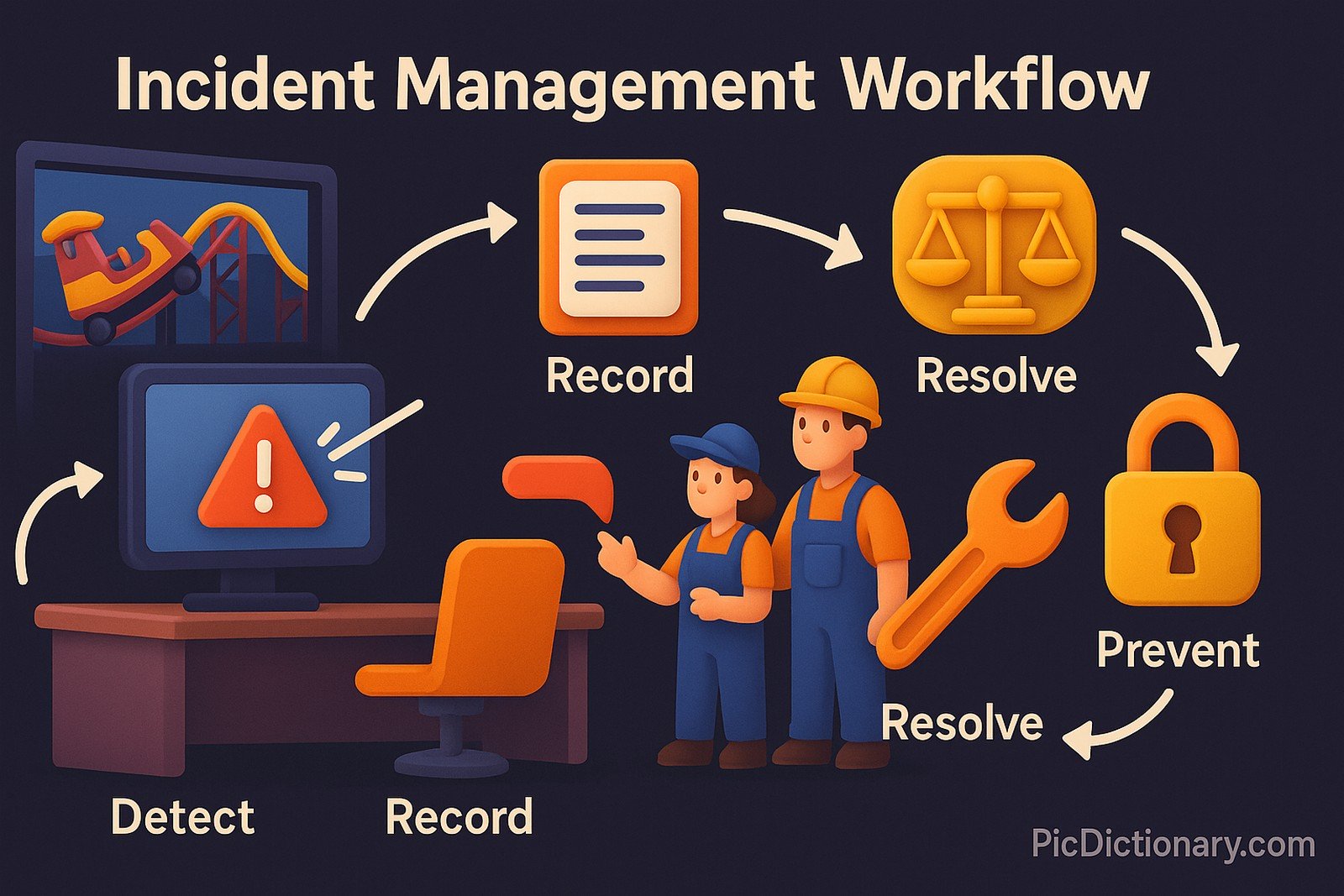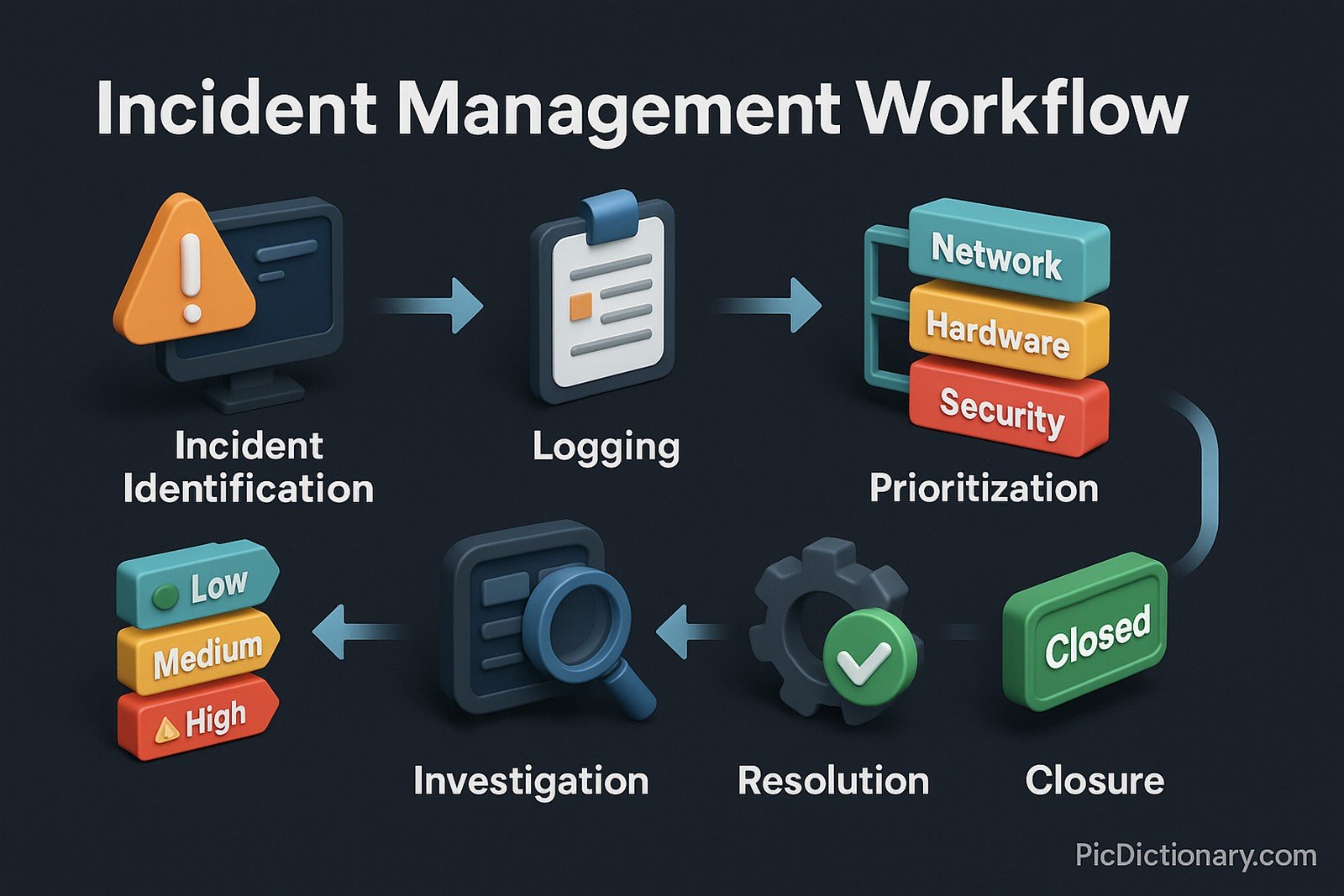Incident Management Workflow

Quick Navigation:
- Incident Management Workflow Definition
- Incident Management Workflow Explained Easy
- Incident Management Workflow Origin
- Incident Management Workflow Etymology
- Incident Management Workflow Usage Trends
- Incident Management Workflow Usage
- Incident Management Workflow Examples in Context
- Incident Management Workflow FAQ
- Incident Management Workflow Related Words
Incident Management Workflow Definition
Incident Management Workflow refers to the structured process that organizations follow to detect, document, analyze, and resolve IT or security incidents efficiently. This workflow ensures minimal service disruption and quick restoration of normal operations. It typically involves key steps such as incident identification, logging, categorization, prioritization, investigation, resolution, and closure. Tools like IT Service Management (ITSM) platforms help automate and streamline this workflow for faster response times.
Incident Management Workflow Explained Easy
Imagine you’re in charge of a big theme park, and sometimes things go wrong, like a ride breaking down. You have a special team that quickly finds out what’s wrong, writes it down, figures out how serious it is, fixes it, and makes sure it doesn’t happen again. That’s exactly what an Incident Management Workflow does in IT—making sure problems in computer systems are fixed quickly to keep everything running smoothly.
Incident Management Workflow Origin
The concept of incident management evolved from IT service management frameworks like ITIL (Information Technology Infrastructure Library), which gained prominence in the 1980s. As businesses became more dependent on technology, the need for structured workflows to manage IT incidents became critical to ensuring reliability and security.
Incident Management Workflow Etymology
The phrase "Incident Management Workflow" comes from:
- Incident – An unplanned event or disruption affecting services.
- Management – The process of controlling and resolving the incident efficiently.
- Workflow – A predefined sequence of steps taken to manage incidents effectively.
Incident Management Workflow Usage Trends
With the rise of cybersecurity threats, cloud computing, and remote work, Incident Management Workflows have become more automated and integrated with AI-driven monitoring tools. Organizations are increasingly adopting ITSM platforms like ServiceNow, Jira Service Management, and BMC Helix to streamline incident handling, reducing downtime and improving customer experience.
Incident Management Workflow Usage
- Formal/Technical Tagging:
- IT Service Management (ITSM)
- Incident Response
- ITIL Framework
- Network Operations Center (NOC) - Typical Collocations:
- "incident management process"
- "automated incident resolution"
- "service desk workflow"
- "real-time incident monitoring"
Incident Management Workflow Examples in Context
- A financial institution uses an Incident Management Workflow to address cybersecurity breaches before they impact customer data.
- IT teams rely on Incident Management Workflows to quickly resolve server outages and ensure business continuity.
- A hospital's IT department implements an Incident Management Workflow to minimize downtime in electronic health record systems.
Incident Management Workflow FAQ
- What is an Incident Management Workflow?
It is a structured process organizations use to detect, analyze, and resolve IT or security incidents efficiently. - Why is an Incident Management Workflow important?
It helps prevent prolonged system outages, reduces business risks, and improves service reliability. - What are the key steps in an Incident Management Workflow?
The typical steps include identification, logging, categorization, prioritization, investigation, resolution, and closure. - Which tools are used for Incident Management Workflow?
Popular tools include ServiceNow, Jira Service Management, and BMC Helix. - How does automation improve Incident Management Workflow?
Automation helps detect and resolve issues faster, reducing manual intervention and downtime. - What is the difference between Incident Management and Problem Management?
Incident Management focuses on immediate resolution, while Problem Management aims to find the root cause and prevent recurrence. - How do IT teams prioritize incidents?
Incidents are prioritized based on severity, impact, and urgency to ensure critical issues are resolved first. - What is ITIL in relation to Incident Management Workflow?
ITIL provides best practices for managing IT services, including structured incident resolution processes. - Can AI be used in Incident Management Workflows?
Yes, AI-driven tools can predict, detect, and even resolve incidents automatically. - How can companies improve their Incident Management Workflow?
Companies can implement automation, use real-time monitoring, and train IT teams to follow best practices.

Incident Management Workflow Related Words
- Categories/Topics:
- IT Service Management (ITSM)
- Cybersecurity
- Network Operations
- Business Continuity
Did you know?
The first recorded IT incident management framework was developed in the 1980s as part of ITIL's initial release. Today, organizations worldwide follow these guidelines to handle millions of incidents daily, ensuring smooth digital operations.
PicDictionary.com is an online dictionary in pictures. If you have questions or suggestions, please reach out to us on WhatsApp or Twitter.Authors | Arjun Vishnu | @ArjunAndVishnu

I am Vishnu. I like AI, Linux, Single Board Computers, and Cloud Computing. I create the web & video content, and I also write for popular websites.
My younger brother, Arjun handles image & video editing. Together, we run a YouTube Channel that's focused on reviewing gadgets and explaining technology.



Comments powered by CComment